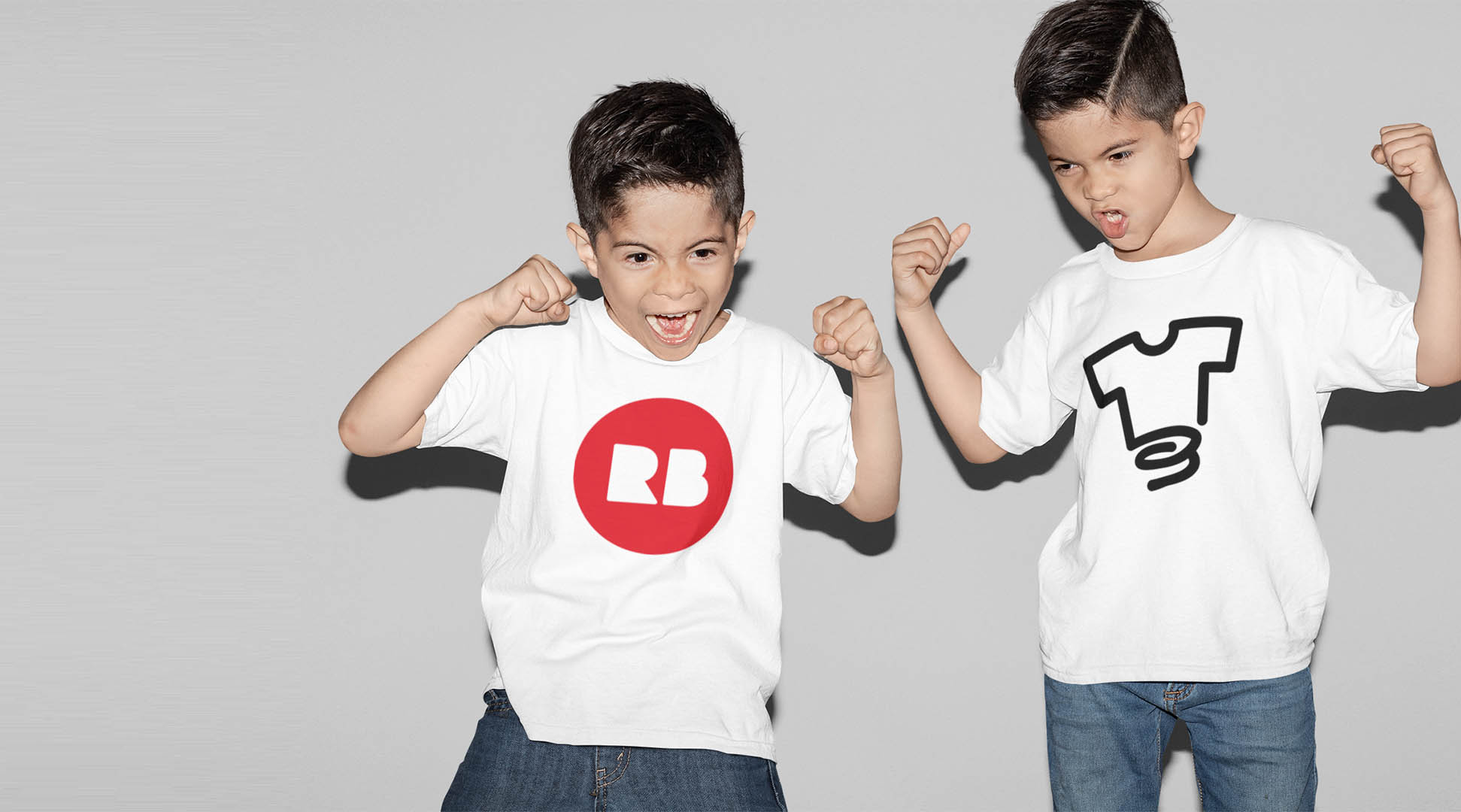Teespring and Redbubble are print-on-demand (POD) e-commerce platforms that cater to content creators, designers, and social media influencers. Each platform can help users sell customized merchandise, while they handle the production and shipping.
Teespring and Redbubble, as Print-on-demand (POD) online stores, assist independent artists in generating income beyond their social media following. Both platforms meet the essential criteria of an online market. Teespring surpasses Redbubble with integration, and Redbubble’s website is faster.
POD is a proven profitable business model. Many independent designers, creatives, and influencers have succeeded in sustaining an income with POD platforms. Passive income is generated and maintained as individuals grow their online presence.
Teespring Vs. Redbubble (Which One is Best for 2023)
Teespring and Redbubble allow social media influencers and creators a chance to compete in the online marketplace. These supply services are a great way to reach a global audience. How do they compare according to product and customer service criteria?
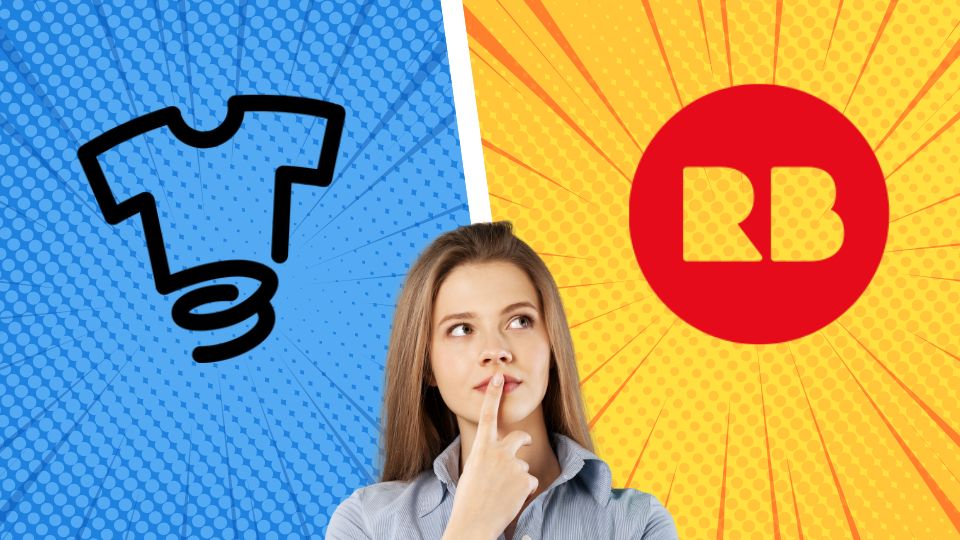
What is Teespring?

Teespring is a free online POD platform, and its services are specifically catered to content creators, like social media influencers, YouTube, TikTok, and Instagram. Established in 2011, this American-based e-commerce company introduced merch shelf integration in partnership with YouTube in 2018.
The merch shelf feature provides YouTube creatives to sell their products through direct links in the description box below their video uploads. This integration feature has substantially increased the earning power of independent artists and designers.
Currently, Teespring is rebranding, changing its name to Spring. Their website, design, and logo have made this transition in 2021. However, Teespring and Spring are used interchangeably, and a few features of the changeover has yet to be finalized.
What is Redbubble?
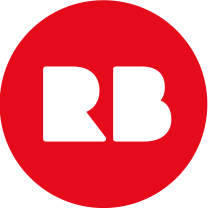
Redbubble established its online market in 2006 and is based in Australia. Redbubble acts primarily as an online marketplace and doesn’t facilitate social media integration. It doesn’t allow influencers to incorporate their website on their platform. Redbubble lets you set up a virtual storefront and is a standalone platform.
Redbubble has grown exponentially over the years, marketing user-submitted designed products. There are approximately 700,000 designers on Redbubble at present.
As a creator, Redbubble has limitations that are disadvantageous to marketing your brand. You cannot apply your store branding or upload your brand name or tagline. Your designs are sold alongside other storefront products. Your branding is done on the products themselves.
Redbubble gives you a percentage of the sale price- called a royalty. If you’ve accumulated more than $20, Redbubble will deposit it into your verified PayPal account monthly. Payments post on the 15th monthly.
When you upload a design to Redbubble, you must be aware of how its search engine operates to increase the chance of your products being showcased. After you upload your design, you can provide a short product description. As with Google, It’s best to use the right keywords for Search Engine Optimization (SEO).
Pros and Cons of Print-On-Demand Platforms
There are many advantages to engaging with POD online platforms. These include no risk, no overhead costs, no upfront investment, no wasted materials, and no excess inventory. Moreover, shipping and customer service are beyond your concern.
As the POD companies oversee logistics and customer service, designers don’t have full control over the products and processes. Therefore you can’t guarantee your subscriber’s satisfaction. Additionally, designers have no control over quality.
However, these few disadvantages are overshadowed by the many ways POD is a proven and profitable side hustle.
Teespring Vs. Redbubble- Integration
Platform integration is possibly the most relevant feature when comparing these POD online markets.
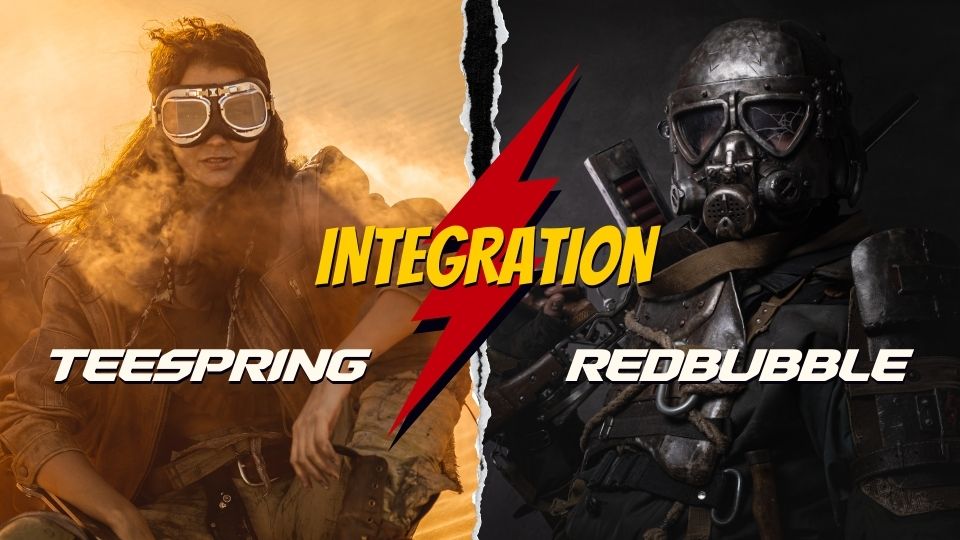
Teespring- Integration
Teespring’s merch shelf is a leading integration feature that outclasses Redbubble. The integration tabs are visible on your Teespring account. Designer-specific merchandise is advertised and marketed via various online platforms.
Social media that Teespring supports includes Instagram, YouTube, Twitch, Linktree, Stream alerts, Discord, PushUpShop, and OnlyFans. As a result, designers can boost their brand and provide exclusively to their followers and subscribers.
Redbubble-Integration
Redbubble’s virtual marketplace is fully equipped, and users can’t upload their social media accounts. Designers are promoted and paid directly from the Redbubble platform. Essentially, Redbubble’s online market only allows artists to set up a storefront. Your designs are listed through your account as Redbubble property.
Redbubble corroborates with third-party applications like Google maps and analytics.
Teespring Vs. Redbubble- Product Quality

Various reviews have stated that their personal experience with the product quality of both teespring and red bubble are good. Print quality on both platforms maintains an acceptable standard. Despite a few rare mishaps, print merchandise meets product quality requirements across all products.
Print quality is not a deciding factor when determining which POD online store is the best. Both produce customized print merchandise of a selling standard. Both e-commerce POD companies’ growth results from consistent customer product satisfaction. It’s essential on each platform to use high-resolution images as a designer.
Teespring’s POD products offer more diversity in one type of item. For example, Teespring has five variations of hats: dad cap, trucker hat, snapback, beanie, and bucket hat. This applies to tech, home, bathroom accessories, sporting, and casual apparel.
Teespring Vs. Redbubble- Customer Support
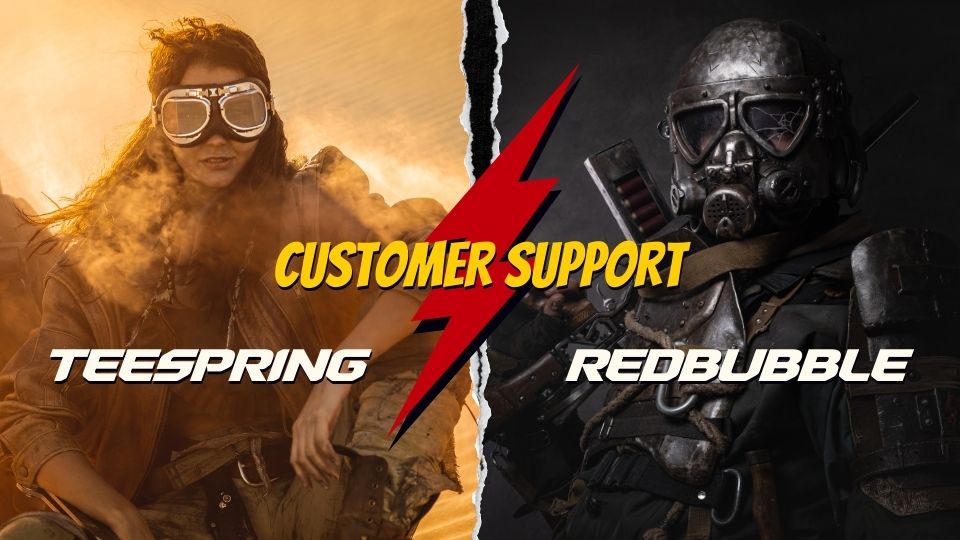
Customer service is one of the more critical aspects of a functioning business. However, customer service isn’t the responsibility of creators or influencers. Therefore, knowing the level of excellence of both Teespring and Redbubble is invaluable to your brand.
According to a few reviews, customer service needs improvement for Redbubble and Teespring. However, the overall structure of customer support for each is commendable. There’s an array of contact options, FAQs, and up-to-date social media outlets online. Furthermore, both sites have surveys that allow creators to give critical feedback.
Teespring- Customer Support
Buyers and sellers can contact Teespring at any time, with a guaranteed instant response. On their “Welcome to Spring Answers” web page, you can ask any question. The immediate electronic preempted replies are helpful and easy to understand. If you still need help, you’ll be directed to the necessary webpage.
There are sectioned categories below the “Spring Answers” search engine, divided into: about my order, about Spring, billing, shipping, and understanding policies. These are further divided into various questions and links to FAQs pages. Additionally, there are designated email addresses specific to the category of your query.
I found Teespring’s customer support service excellent. Their response to my email was immediate, and the issue was resolved within 15 minutes. However, several bad reviews detail Teespring’s poor service. It’s a balanced mix, with rave reviews and disparaging ones.
Essentially, Teespring’s customer support is thorough and exact. Every anticipated issue is addressed. As a creative, I’m reassured by the amount of time Teespring has placed into customer care. Additionally, I was given a short survey after my email correspondence.
Redbubble- Customer Support
Redbubble provides quality customer service 24/7. You can reach Redbubble customer support via Twitter or by opening a customer support ticket. If you’re not on Twitter, you can open a customer support ticket on Redbubble’s website.
You can’t email or live chat with their support service. This limitation is a significant flaw in Redbubble’s business model, as emails are universal, and Twitter is exclusive. However, the customer support service delivered on Twitter offers transparency and quick live updates.
The response is instant and helpful, and issues are typically resolved within minutes of the query. If you aren’t dealt with immediately, you should get a response within 24 hours. A 24-hour delay time is the amount of time Redbubble has committed to addressing needs and problems.
The help page on Redbubble’s website is an alternative to contacting customer support. Here are solutions for designers and buyers to self-navigate. The range of issues, problems, and challenges anticipated by Redbubble is thorough and impressive. In addition, the self-help webpage is user-friendly and will likely resolve whatever issue you may be facing.
Additionally, Redbubble has several different online accounts that keep buyers and sellers up-to-date with news, problems, emergencies, and various issues. Redbubble’s online presence includes Facebook, Instagram, Pinterest, and Tumblr.
There has been a report whereby numerous Redbubble accounts and products were suddenly suspended. Redbubble took six days to respond. The response was vague and unapologetic. It destroyed confidence in Redbubble. Despite this, Redbubble generally offers excellent customer service.
Teespring Vs. Redbubble- Pricing
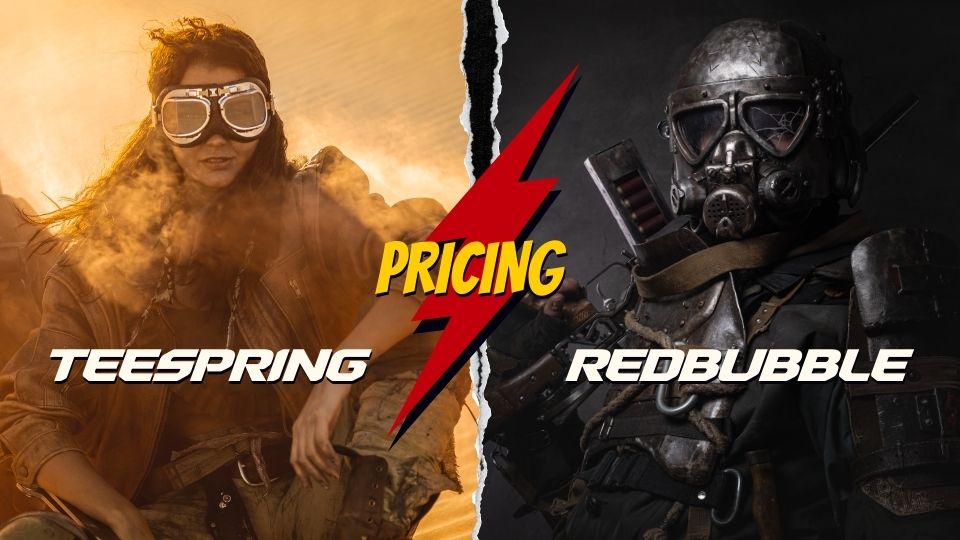
These POD online markets offer recommended prices above the fixed base price. The base cost is the price charged to a product before the designer’s profit margin is added. Therefore, the base price plus the artist’s margin equals the retail price.
The base price includes marketing, manufacturing, and online hosting of the artist’s products.
On both platforms, designers are given a chance to adjust their profit margin. The estimated profit margins are reasonable, increasing the chance of sales.
POD is a highly competitive market. Fortunately, securing a profit is inevitable, as the base costs are fair.
Teespring and Redbubble offer the creator a chance to create promotions and specials to maintain buyer interest and promote their products. They offer insights, strategies, and analytics, informing and educating designers.
Teespring Product Prices
Teespring’s product prices are considerably more affordable than Redbubble’s. In addition, Teespring has excellent specials whereby the more you sell, the cheaper the base cost of the product. Pricing discount is a sizeable discount policy that benefits content creators meaningfully. Additionally, this policy exceeds any POD online platforms discount and specials.
Teespring, being free, entails that the creators keep 100% of the profit. As of the 27th of September 2022, the base cost of a classic tee is $16,50, a classic pullover hoodie is $31,95, and a classic crewneck sweatshirt is $26,28. The base cost for women’s apparel is slightly more.
On its website, Teespring offers complete transparency. There’s a page that details every item and the base cost. This is an excellent business feature; it keeps content creators honest and the competition fierce. Designers are pushed to promote unique, highly-sought after products and content to engage with a global audience.
Redbubble Product Prices
Redbubble’s help center page details the company’s policies regarding base prices and profit margins. It is very similar to Teespring, reasonable and affordable. When you upload your product you see the base cost and profit margin.
Teespring Vs. Redbubble- Shipping and Fulfillment
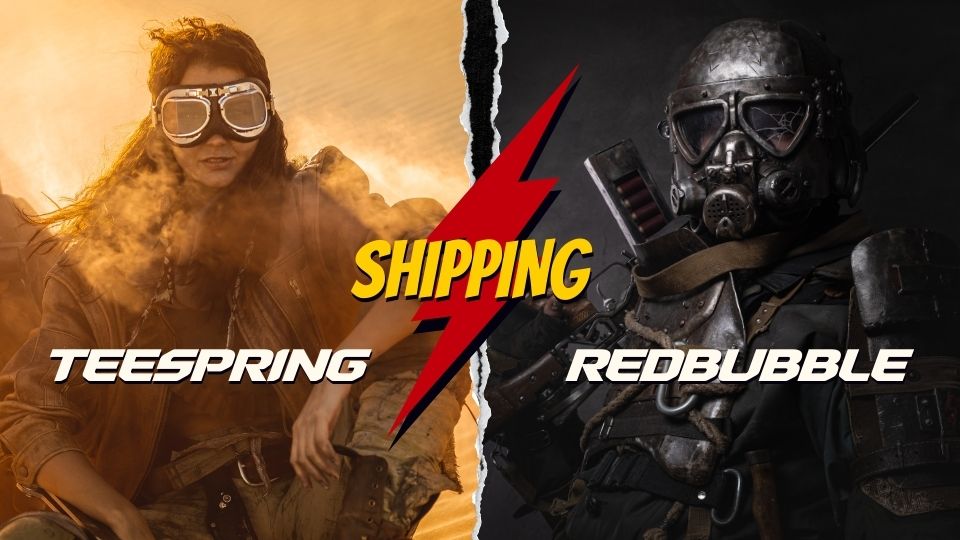
Fortunately, these online stores handle shipping- costs, distribution, and manufacturing. Therefore, the risks involved with shipping and delivery are solely on the shoulders of the POD online markets. Shipping involves several variables: distance, location, product type, and shipping method.
Express orders will charge more for faster delivery, and local order will reach their destination quicker than international orders.
If a product fails to reach its destination, the POD companies offer buyers a full refund or a second delivery. The refund and second delivery are final, and the option won’t be present if the delivery fails again.
Teespring and Redbubble are equal in shipping and service delivery. These social e-commerce companies allow their customers to track their parcels, change the destination, and cancel purchases.
Teespring- Shipping
Teespring shipping is standard. Items are charged on basic variables, and customers will be charged extra depending on commodity, distance, and location. Moreover, an extra $2 will be charged for each additional product included in the package.
Teespring delivers on holiday at an extra fee and delivery deadline extension.
Redbubble- Shipping
Redbubble’s reach extends worldwide except in Syria, North Korea, Cuba, and Sudan. They only use well-established and well-reputed couriers like FedEx, UPS, and DHL.
Redbubble delivers on working days only. It offers buyers a real-time tracker in which they can monitor the route of their order.
Unfortunately, Redbubble doesn’t offer an umbrella charge if multiple products are ordered. That is, each product is charged and treated as if it’s a single order. As a result, the shipping price could become staggering.
Teespring Vs. Redbubble- Usability
The websites of both POD platforms are user-friendly and easy to understand. However, Teespring is incredibly slow. On the other hand, Redbubble is fast, efficient, and easy to navigate.

Teespring- Usability
Teespring is effortless to use and enjoyable. However, it’s extremely slow, frustrating and detracts value from experience.
Another failure of an otherwise worthwhile system is that when preparing your product listing (stage three after generating the image and saving), an error frequently occurs, stating that your listing won’t be finalized and presented to your followers. The error is vague and suggests I contact customer service.
I’ve had this error for two days, and the issue hasn’t naturally corrected itself. So I have to delete and resubmit my designs. Moreover, my partner, across the globe, was anticipating product release days ago, and it appears to be a failure on my part.
Redbubble- Usability
Redbubble is simple and fast. There are no unnecessary interruptions, and the designs are realized on the merch instantly. Again I must stress that there’s an alienating feeling when working on Redbubble that I can’t shake.
This is probably due to its integration policies, or my merchandise is alongside hundreds of thousands of others. Without my specific branding or YouTube channel integration, I feel a bit hopeless at the chance of sales.
Redbubble is simple and incredibly fast. Setting up my account was effortless, and uploading the design was a breeze. Unfortunately, the products aren’t as diverse and numerous as Teespring.
Teespring Vs. Redbubble- Overall Main Differences
The difference between Teespring and Redbubble lies mainly in integration and product cost.
| Criteria | Teespring | Redbubble |
| Integration | Yes | No |
| Product Quality | Good, Selling Standard | Good, Selling Standard |
| Product Prices | Affordable, Can adjust profit margin | Affordable, Can adjust profit margin |
| Shipping | Reasonable, Reliable, Subject to variables | Reasonable, Reliable, Subject to variables |
| Customer Support | 24/7, email, help page, customer support ticket, live chat, Spring answers search engine, help page, FAQs | 24/7, twitter, customer support ticket, no email, no live chat, various social media accounts, help page, FAQs |
| Organic Traffic | SEO and social media integration | SEO |
| Website Usability | Slow, Easy, Enjoyable | Fast, Easy, Lacks intimacy |
| Comparison Outcome | A great POD platform that assists influencers and content creators | A great POD platform that assists influencers and content creators |
Conclusion
Teespring and Redbubble are well-established POD e-commerce platforms. They have similar business models and meet the usual standard requirements.
While Teespring outshines Redbubble’s marketplace and SEO dependence as it facilitates social media integration, Redbubble’s website is substantially faster than Teespring’s and has a slightly higher review score on Trustpilot and other major tech review platforms.
Bryan E. Robinson is the former owner of TshirtGrowth. He has sold t-shirts since 2006 through dropshipping, screen printing, vinyl printing, DTG, Print on Demand, and more. Bryan has created his own t-shirt designs through Photoshop, Canva, and other platforms, as well as worked with freelancers to create many of his designs. Besides t-shirts, Bryan has over 18 years of experience in online marketing with eCommerce, B2B SaaS, B2C products, and more.

